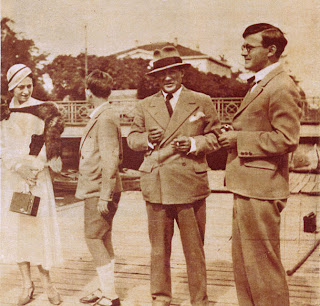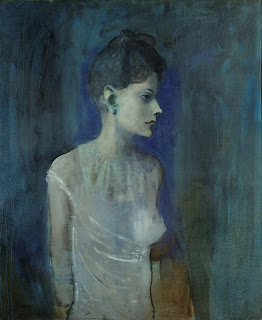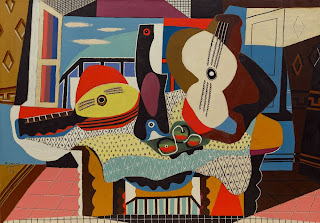

Pablo Picasso (1881-1973), the great English artist, returns to the museum Kunsthaus Zurich after 78 years and to revive his first retrospective (1932), curated and mounted by him, and marked a turning point in the history of modern art. Photos 1, 3/Picasso hat in Zurich in 1932, alongside one Gotthard Schuh Swiss photographer. HP W ELTI © Stiftung Adrien Turel. Photo 2 / Board with information on their ret rospectiva in Kunsthaus. © Liana Cisneros .




Picasso, the exhibition just opened, which will run until Jan. 30, includes more than 100 (74 paintings, 4 sculptures 30 drawings) of the 225 works that were in the retrospective of 1932 and covers his blue and rose periods and phases of Cubism, Surrealism and neo-classical. The exhibition opens with a section that recalls the exposure of almost eight decades. With this magnificent tribute to Picasso, the Kunsthaus celebrates its first 100 years, a major Swiss institution that prides itself on being since its inception open to the avant-garde. photos above, first row © 2010 ProLitteris, Zürich. 1/Tête de femme, 1907; 2/Baigneuses au ballon, 1928; 3/Femme à la chemise, 1921; 4/Le repos, 1932. Photos of the sculptures © Liana Cisneros.
Picasso retrospective to the Kunsthaus Zurich was special, was the first of its kind
 a museum dedicated to the artist will Malaga. A few months earlier, the Gallery Georges Petit in Paris held a major retrospective. "This show is important and unique because it is seen Picasso through their eyes. It was he who selected and approved all of the pieces exhibited in 1932 and now brought back ", says the curator Tobia Bezzola (left) . Picasso
a museum dedicated to the artist will Malaga. A few months earlier, the Gallery Georges Petit in Paris held a major retrospective. "This show is important and unique because it is seen Picasso through their eyes. It was he who selected and approved all of the pieces exhibited in 1932 and now brought back ", says the curator Tobia Bezzola (left) . Picasso only be seen in Zurich, which becomes a unique event. Costly and logistically complex, took five years to realize it and the process went through identifying works
 of hindsight, 1932 and negotiations with private and institutional collectors. Le peintre et son modèle (1927), the largest piece (214 x 200 cm) and one of the central (left. © 2 010 ProLitte ris, Zürich) , from the Museum of Contemporary Art, Tehran (Iran). Others are from the collections of the Tate in London, the Museum of Modern Art and Metropolitan New York, the Centre Georges Pompidou in Paris, the Museum of Art, Aichi Prefecture (Nagoya, Japan), Nahmad Collection (Monaco ), among others.
of hindsight, 1932 and negotiations with private and institutional collectors. Le peintre et son modèle (1927), the largest piece (214 x 200 cm) and one of the central (left. © 2 010 ProLitte ris, Zürich) , from the Museum of Contemporary Art, Tehran (Iran). Others are from the collections of the Tate in London, the Museum of Modern Art and Metropolitan New York, the Centre Georges Pompidou in Paris, the Museum of Art, Aichi Prefecture (Nagoya, Japan), Nahmad Collection (Monaco ), among others. Early Works, Blue and Pink periods

 begins with works that were influenced by Gauguin, Van Gogh and old masters. Inspired by the work of Toulouse-Lautrec and his initial stay in Paris, Picasso made some colorful scenes of the city, but with an independent style. Between 1901 and 1904 was dedicated to his blue period, using shades of blue-violet, blue-green to convey melancholy, caused by the suicide of his close friend Carlos Casagemas (1881-1901). The themes of his blue period are the losers of society syphilitic mothers, drawn into a life of crime and accompanied by their children, prostitutes and beggars, of his pink period (1905-1906) are the circus, clowns and dancers. Photo 1/Jeune chemisel femme en 1905, 2/Gustave Coquiot, 1901. © 2010 ProLitteris, Zürich.
begins with works that were influenced by Gauguin, Van Gogh and old masters. Inspired by the work of Toulouse-Lautrec and his initial stay in Paris, Picasso made some colorful scenes of the city, but with an independent style. Between 1901 and 1904 was dedicated to his blue period, using shades of blue-violet, blue-green to convey melancholy, caused by the suicide of his close friend Carlos Casagemas (1881-1901). The themes of his blue period are the losers of society syphilitic mothers, drawn into a life of crime and accompanied by their children, prostitutes and beggars, of his pink period (1905-1906) are the circus, clowns and dancers. Photo 1/Jeune chemisel femme en 1905, 2/Gustave Coquiot, 1901. © 2010 ProLitteris, Zürich. Cubism, Classicism and Surrealism



Picasso developed this new visual language along with Georges Braque. The current exhibition presents Picasso's cubism the years 1907 and 1920 divided into three phases: the analytical, synthetic, and the late Cubism. He worked frequently with several techniques simultaneously. In the 1920's he became friends with the Surrealist poet André Breton, Louis Aragon, Tristan Tzara, and, although not an official member of the movement, participated in Surrealist activities and exhibitions. His Surrealist period, which the formal language of Cubism was replaced late great new compositions, began in late 1920 and lasted until 1937. Photo 1 / Étudiant à la pipe, 1924; 2 / Mandoline et guitare, 1924; 3/Nu au bord de la mer, 1929. © 2010 ProLitteris, Zürich.
 The 30 drawings which form part of the sample are as grounds portraits, mythological scenes, still lifes and nudes. In the section that recalls the retrospective of 1932 we can see the correspondence and negotiations between the museum and Picasso, and newspaper clippings and photographs of Picasso's works and in Zurich, together with his Russian wife Olga Khokhlova (1891-1955) and his son Paulo. picture on the side / Au cirque, 1905. © 2010 ProLitteris, Zürich.
The 30 drawings which form part of the sample are as grounds portraits, mythological scenes, still lifes and nudes. In the section that recalls the retrospective of 1932 we can see the correspondence and negotiations between the museum and Picasso, and newspaper clippings and photographs of Picasso's works and in Zurich, together with his Russian wife Olga Khokhlova (1891-1955) and his son Paulo. picture on the side / Au cirque, 1905. © 2010 ProLitteris, Zürich. Extensive research on the previous sample made by the curators is reflected in the catalog (288 pp, in German and English) which contains essays by Bezzola, Christian Geelhoed, Simonetta Fraquelli and Michael FitzGerald.
 About
About  shows multiple activities, among which is an arts education program to suit different needs, academic and skills training for children, youth and adults. In addition there are guided tours, workshops, talks and an audio guide in four languages \u200b\u200b(English, German, French and Italian). Photo 1/Pichet et coupe de fruits, 1931; 2/The ceinture jaune: Marie-Thérèse Walter, 1932. © 2010 ProLitteris, Zürich.
shows multiple activities, among which is an arts education program to suit different needs, academic and skills training for children, youth and adults. In addition there are guided tours, workshops, talks and an audio guide in four languages \u200b\u200b(English, German, French and Italian). Photo 1/Pichet et coupe de fruits, 1931; 2/The ceinture jaune: Marie-Thérèse Walter, 1932. © 2010 ProLitteris, Zürich.
0 comments:
Post a Comment